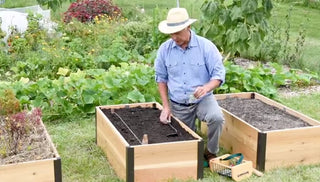Did you recently purchase a raised bed kit? Or perhaps you're a DIY-er and you've just completed assembling your own raised bed? Congrats! You're well on your way to a season full of flowers, herbs, veggies and fruits. Once you've assembled and sited your new raised bed, it's time to get gardening!
In this 4-part video, our friend and gardening expert Charlie Nardozzi explains how to fill, plant, and tend your raised bed:
Healthy soil as the foundation for success
Fill your raised bed with a blend of topsoil and compost. Your garden soil should be dark in color and crumbly in texture — a fluffy, aerated soil will encourage strong root growth. Leafy greens and smaller herbs can grow just fine in 6-8 inches of soil, however larger, deep-root crops liike tomatoes require at least 18 inches of planting depth. When in doubt, err on the side of deeper soils!
Planting schemes
There are plenty of ways to plant up your raised bed. Planting in rows is ideal if you have an especially large planting area to cover. Broadcast seeding, however, is a great way to maximize your space and get the largest number of plants in a smaller space. If you are looking to get a steady harvest of a particular crop all summer long, be sure to employ succession planting. And of course, don't feel like direct seeding is the only way to plant up your garden — transplanting in slightly more mature plants is a great way to get your garden up and running faster. Colder growing zones may only have a few months of warm temperatures; transplants offer gardeners a harvest head start!
Watering, fertilizing, and mulching
Consistent watering is vital to garden success — this is especially true for young seedlings. Small seedlings require daily watering until they develop deeper roots. Unless you are gardening in an especially hot, dry, climate, mature plants will likely need watering just a few times a week. A soaker-style irrigation hose can help get water directly to the soil and roots, and reduce the amount lost to evaporation. Be sure to tuck some biodegradable mulch around your plants to further prevent water loss, and add some organic matter back in to your soil.
Protecting plants from weather and pests
One of the biggest benefits of gardening in a raised bed is the ease in which you can deploy row covers and other types of plant protection. Row covers, garden fabric, crop covers, and cloches are all effective, earth-friendly ways to protect plants from pests (both animal and insect) AND extreme weather (both heat and frost).
Related Article: Everything You Need To Know About Gardening In Raised Beds





